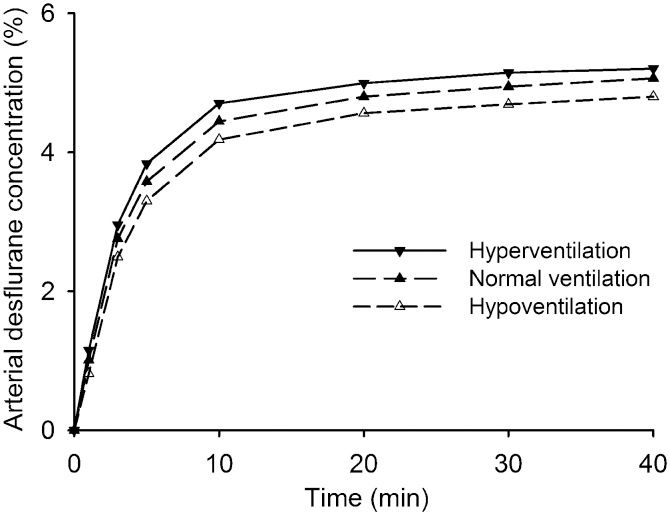Lu et al. described that hyperventilation accelerated the desflurane uptake from the alveolar to the arterial blood (1). It is a very intriguing study of a direct determination of the desflurane concentration in the arterial blood (Ades). In comparison to the end-tidal volatile anesthetic concentration, the arterial concentration of a volatile anesthetic is more likely to reflect its concentration in the brain (1-3).
A pharmacokinetic model for volatile anesthetics has been developed and used for over 25 years (4). Therefore, the effect of ventilation on Ades can be simulated with this model. Gas Man® (Version 4.1, Med Man Simulations, Inc., Chestnut Hill, MA, USA) is a computer simulation program which contains a five-compartment system built statistically which simulates the pharmacokinetics for volatile anesthetic uptake and distribution (4) with embedded parameters (5). This program helps users and readers understand anesthetic uptake and distribution with graphs. If the embedded parameters are adjusted prior to a simulation, simulated results can be seen in graphs individually.
For the simulations, the necessary parameters and patient data were taken from the report of Lu et al. (1): an anesthesia breathing circuit volume of 6 L; a fresh gas flow of 6 L/min; a functional residual capacity of 2.4 L; 61.8, 62.0, and 58.0 kg patient (hyperventilation, normal ventilation, and hypoventilation, mean values from each group); an alveolar minute ventilation of 3.33, 2.38, and 1.80 L/min, mean values from each group; cardiac output which was derived from the cardiac index of the report of Lu et al. with Du Bois method (5.38, 5.56, and 5.36 L/min, mean values from each group). Other parameters were not manipulated. Therefore, the values for compartment volumes (vessel rich group, muscle, fat, and venous group) and the values for regional blood flow percentages (vessel rich group, muscle, and fat) showed some differences depending on the entered weight. At 0, 1, 3, 5, 10, 20, 30, and 40 minutes, the simulated Ades were recorded.
In these simulations, despite having some limitations on the data used (e.g. using mean values of weight and alveolar ventilation) in the report of Lu et al, Gas Man® shows similar trends with the simulated Ades just as those of Lu et al (1). Hyperventilation seems to produce a higher Ades-over-time curve than normal ventilation and hypoventilation. Simulated Ades in the hyperventilation group also seems to increase more rapidly than those in the normal ventilation and the hypoventilation groups during the first 5 minutes (Figure 1.
No potential conflict of interest was reported.





